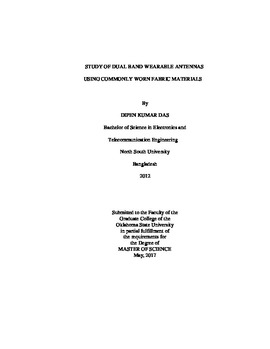| dc.contributor.advisor | Bunting, Charles | |
| dc.contributor.author | Das, Dipen Kumar | |
| dc.date.accessioned | 2018-03-13T18:15:33Z | |
| dc.date.available | 2018-03-13T18:15:33Z | |
| dc.date.issued | 2017-05-01 | |
| dc.identifier.uri | https://hdl.handle.net/11244/54514 | |
| dc.description.abstract | In recent years, body-centric communication has become one of the most attractive fields of study. The versatile applications of body-centric communication not only being used for health monitoring, but also for real-time communication purposes in special occupations. They are important for supporting a population with increasing life expectancy and increase the probability of survival for the people suffering from chronic illness. For both wearable and implantable form of body-centric communication, characterizing the system electromagnetically is very important. Given the constraints in power, size, weight and conformity, one of the most challenging parts become the designing antenna for such communication systems. Wearable antennas are the most popular option regarding these issues. Wearable antennas are easier and simpler to mount on clothing when they are made of textile materials. In the process of designing a textile antenna, the availability of the fabrics is pivotal to mount on regularly worn clothes. In this report, several designs of a co-planar waveguide microstrip patch antenna are presented. Instead of felt fabric, the antenna was modified using 100% polyester and cotton fabric for the substrate material. A parasitic patch slot was created on the co-planar ground plane to achieve the dual band resonance frequencies at 2.4 GHz and 5.15 GHz. The geometrical modifications of the antennas were described and their performances were analyzed. The antenna achieved resonating frequency with a thinner substrate as the dielectric constant went higher for the fabrics. The design with different fabric materials was first simulated in CST Microwave Studio, then fabricated and measured in a regular environment. They were also mounted on a 3-D printed human body model to analyze the bending effect. The design of the antennas shows satisfactory performance with a good -10dB bandwidth for both the lower and higher desired resonating frequency band | |
| dc.format | application/pdf | |
| dc.language | en_US | |
| dc.rights | Copyright is held by the author who has granted the Oklahoma State University Library the non-exclusive right to share this material in its institutional repository. Contact Digital Library Services at lib-dls@okstate.edu or 405-744-9161 for the permission policy on the use, reproduction or distribution of this material. | |
| dc.title | Study of Dual Band Wearable Antennas Using Commonly Worn Fabric Materials | |
| dc.contributor.committeeMember | Scheets, George | |
| dc.contributor.committeeMember | Ekin, Sabit | |
| osu.filename | Das_okstate_0664M_15210.pdf | |
| osu.accesstype | Open Access | |
| dc.description.department | Electrical Engineering | |
| dc.type.genre | Thesis | |
| dc.type.material | text | |
